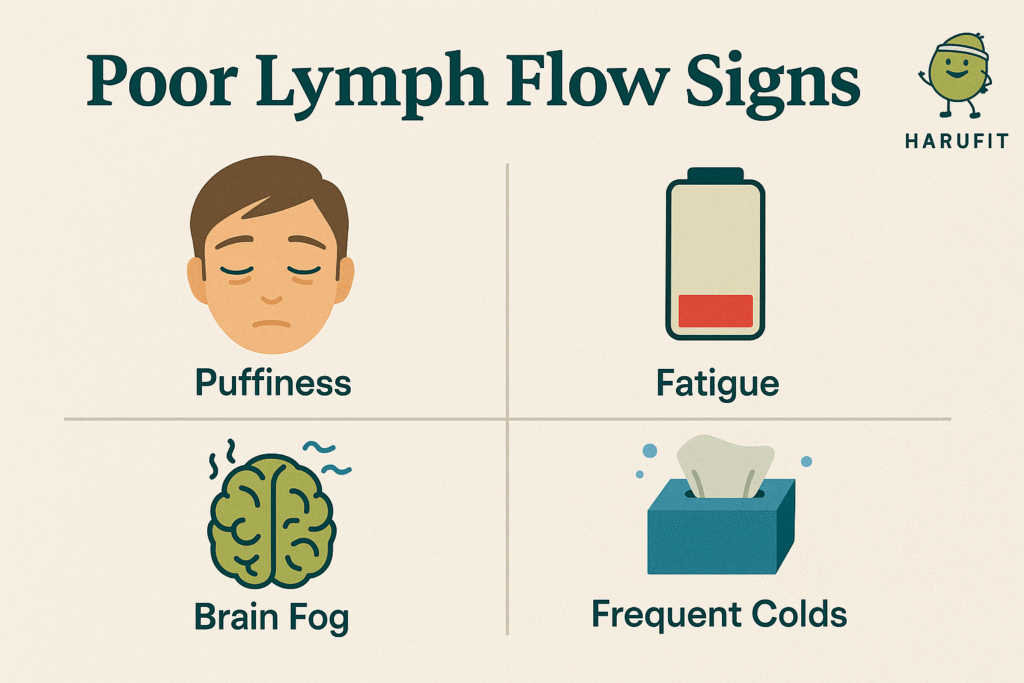Always Tired and Puffy? Your Lymph Flow Might Be the Reason

Persistent fatigue and puffiness may indicate your lymphatic system needs support
Always Tired and Puffy? Your Lymph Flow Might Be the Reason

What’s Really Happening in Your Body
Ever feel completely drained after a full night’s sleep, or notice persistent puffiness around your eyes and face? The culprit might be your lymphatic system struggling to keep pace with your body’s needs.
Here’s what makes lymph different: unlike your cardiovascular system, which relies on your heart as a central pump, lymphatic fluid depends entirely on muscle movement and physical activity to circulate. When this flow becomes sluggish, cellular waste accumulates, inflammation rises, and your immune defenses weaken.
The good news? When your lymphatic system functions optimally, you’ll experience clearer skin, improved mental clarity, faster exercise recovery, and stronger resistance to illness.

Recognizing the Warning Signs
Your lymphatic system may be sending distress signals if you’re experiencing:
✓ Persistent exhaustion that quality sleep doesn’t seem to resolve
✓ Facial or extremity swelling that worsens throughout the day
✓ Cognitive fog that makes concentration difficult
✓ Tender lymph nodes that feel like small, moveable lumps beneath the skin
✓ Compromised skin health including dullness, frequent breakouts, or slow healing
Left unaddressed, poor lymphatic circulation can fuel chronic inflammatory processes and contribute to premature cellular aging.

Modern Lifestyle Factors That Disrupt Flow
Several contemporary habits directly interfere with healthy lymphatic function:
Prolonged sedentary periods reduce the muscle contractions necessary for lymph propulsion
Inadequate hydration causes lymphatic fluid to thicken and move less efficiently
Highly processed diets promote systemic inflammation and fluid retention
Chronic stress responses create shallow breathing patterns and persistent muscle tension
Evidence-Based Approaches That Work
Research demonstrates that targeted lifestyle modifications can significantly improve lymphatic circulation within 2-3 weeks:
💧 Strategic Hydration Protocol
Target 8-10 glasses of quality water daily. Adding fresh lemon juice or a small amount of sea salt enhances cellular absorption. Herbal teas, particularly dandelion and green varieties, provide additional lymphatic support while contributing to your fluid intake.
🏃♀️ Hourly Movement Practice
Set gentle reminders to move for 2-3 minutes each hour. Simple activities like calf raises, shoulder rolls, or brief walks activate the muscular pumps that drive lymphatic circulation. Even light stretching provides measurable benefits.
🫁 Diaphragmatic Breathing Technique
Most adults develop shallow breathing patterns that limit lymphatic flow. Practice this method: inhale slowly for 4 counts through your nose, pause momentarily, then exhale for 6 counts through your mouth. This diaphragmatic action creates a natural pumping mechanism for lymphatic fluid.
🧴 Dry Brushing Consideration
Before showering, gently brush dry skin toward your heart using a natural bristle brush. While scientific evidence remains limited, many practitioners report improved circulation and skin texture with consistent application.
Natural Bristle Body Brush on Amazon –(Affiliate link) a well-made option at a reasonable price point.
“As an Amazon Associate, I earn from qualifying purchases.”
🥬 Anti-Inflammatory Nutrition
Emphasize foods rich in antioxidants and omega-3 fatty acids: berries, leafy greens, citrus fruits, and cold-water fish. Simultaneously reduce processed foods and excess sodium, which can exacerbate inflammation and fluid retention.

Your Simple Daily Support Routine
Here’s a practical approach that integrates seamlessly into any schedule:
Morning (5 minutes): Warm lemon water upon waking, 10 gentle shoulder rolls, 5 deep breathing cycles
Midday (3 minutes): Brief walk or stair climbing, seated spinal rotation, mindful breathing break
Evening (2 minutes): Optional dry brushing before shower, herbal tea with dinner
This 10-minute daily investment provides substantial lymphatic support without overwhelming your routine.
Understanding Long-Term Consequences
Chronic lymphatic congestion extends beyond temporary discomfort. Over time, inadequate drainage can result in recurrent infections, persistent edema requiring medical intervention, autoimmune dysfunction from sustained inflammation, and accelerated aging from accumulated metabolic waste.
Early implementation of supportive practices offers the best protection against these complications.
Universal Benefits Across All Ages
Lymphatic challenges affect people regardless of age or lifestyle. Remote professionals, busy parents, individuals managing chronic fatigue, and anyone experiencing frequent illness can benefit from improved lymphatic function.
The rewards are consistent: enhanced energy levels, clearer complexion, stronger immune response, and improved exercise recovery. Whether you’re establishing healthy habits in your twenties or optimizing wellness in your fifties, your lymphatic system responds positively to the same fundamental support strategies.
Getting Started
Persistent fatigue and puffiness aren’t inevitable aspects of aging—often, your body simply needs better support for its natural detoxification processes.
Choose one manageable change from the strategies above. Perhaps set hourly movement reminders on your phone, or begin adding lemon to your morning water. Small, consistent adjustments create surprisingly significant improvements over time.
The key lies in consistency rather than perfection. Start where you are, and build gradually.
Looking for more evidence-based wellness strategies?
If you’re a new mom dealing with pelvic pain, don’t miss this resource: Postpartum Pelvic Pain: A New Mom’s Recovery Guide
As an Amazon Associate, I earn from qualifying purchases.
Comments